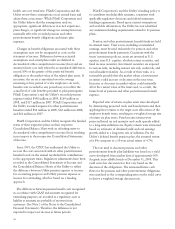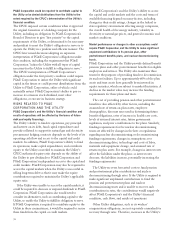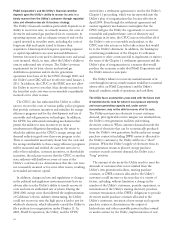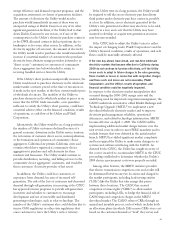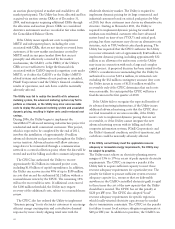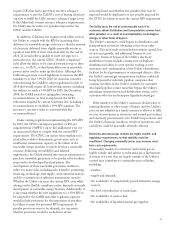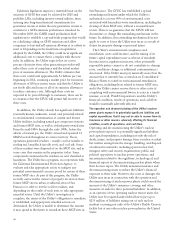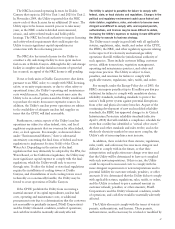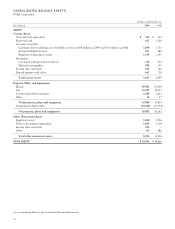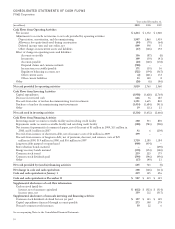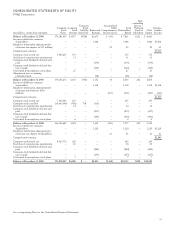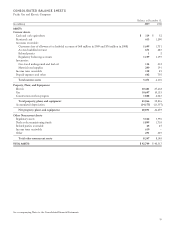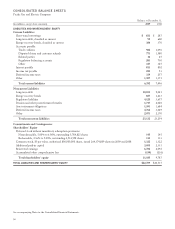PG&E 2009 Annual Report Download - page 50
Download and view the complete annual report
Please find page 50 of the 2009 PG&E annual report below. You can navigate through the pages in the report by either clicking on the pages listed below, or by using the keyword search tool below to find specific information within the annual report.California legislation imposes a statewide limit on the
emission of GHG that must be achieved by 2020 and
prohibits LSEs, including investor-owned utilities, from
entering into long-term financial commitments for
generation resources unless the new generation resources
conform to a GHG emission performance standard. In
November 2009, the CARB issued preliminary draft
regulations to establish a cap-and-trade program that would
set a declining ceiling on GHG emissions and allow
companies to buy and sell emission allowances or offsets to
meet it. Depending on the final form of regulations
adopted by the CARB, the Utility could incur significant
additional costs to ensure that it complies with the new
rules. In addition, the Utility expects that its cost to
procure electricity from other generation providers will
reflect their costs of compliance and the actual market
price of emission allowances. The Utility estimates that
these costs could total approximately $1 billion per year
beginning in 2012, assuming a market price for emissions
allowances of $30 per metric tonne and that the Utility is
not freely allocated some or all of its emission allowances
to reduce customer costs. Although these costs are
expected to be passed through to customers, there can be
no assurance that the CPUC will permit full recovery of
these costs.
In addition, the Utility already has significant liabilities
(currently known, unknown, actual, and potential) related
to environmental contamination at current and former
Utility facilities, including natural gas compressor stations
and former MGP sites, as well as at third-party-owned sites.
From the mid-1800s through the early 1900s, before the
advent of natural gas, the Utility owned and operated 41
MGPs located throughout its service territory. Those
operations generated residues — mainly coal tar (similar to
roofing tar), lampblack (an oily soot), and coal ash. Some
of these residues were disposed of on the MGP site, and in
some cases they remain on the properties today. Some
compounds contained in the residues are now classified as
hazardous. The Utility has a program, in cooperation with
the California Environmental Protection Agency, to
evaluate and take appropriate action to mitigate any
potential environmental concerns posed by certain of these
former MGP sites. As part of this program, the Utility
recently contacted the owners of property located on three
former MGP sites in urban, residential areas of San
Francisco to offer to test the soil for residues, and
depending on the results of such tests, to take appropriate
remedial action. Until the Utility’s investigation is
complete, the extent of the Utility’s obligation to remediate
is established, and appropriate remedial actions are
determined, the Utility is unable to determine the amount
it may spend in the future to remediate these MGP sites in
San Francisco. The CPUC has established a special
ratemaking mechanism under which the Utility is
authorized to recover 90% of environmental costs
associated with hazardous waste remediation, including the
cleanup of these MGP sites, without a reasonableness
review. There is no guarantee that the CPUC will not
discontinue or change this ratemaking mechanism in the
future. In addition, this ratemaking mechanism does not
apply to costs or losses the Utility may incur as a result of
claims for property damage or personal injury.
The Utility’s environmental compliance and
remediation costs could increase, and the timing of its
future capital expenditures may accelerate, if standards
become stricter, regulation increases, other potentially
responsible parties cannot or do not contribute to cleanup
costs, conditions change, or additional contamination is
discovered. If the Utility must pay materially more than the
amount that it currently has accrued on its Consolidated
Balance Sheets to satisfy its environmental remediation
obligations, including those related to former MGP sites,
and if the Utility cannot recover those or other costs of
complying with environmental laws in its rates in a timely
manner, or at all, PG&E Corporation’s and the Utility’s
financial condition, results of operations, and cash flow
would be materially adversely affected.
The operation and decommissioning of the Utility’s nuclear
power plants expose it to potentially significant liabilities and
capital expenditures that it may not be able to recover from its
insurance or other sources, adversely affecting its financial
condition, results of operations, and cash flow.
Operating and decommissioning the Utility’s nuclear
power plants expose it to potentially significant liabilities
and capital expenditures, including not only the risk of
death, injury, and property damage from a nuclear accident
but matters arising from the storage, handling, and disposal
of radioactive materials, including spent nuclear fuel;
stringent safety and security requirements; public and
political opposition to nuclear power operations; and
uncertainties related to the regulatory, technological, and
financial aspects of decommissioning nuclear plants when
their licenses expire. The Utility maintains insurance and
decommissioning trusts to reduce the Utility’s financial
exposure to these risks. However, the costs or damages the
Utility may incur in connection with the operation and
decommissioning of nuclear power plants could exceed the
amount of the Utility’s insurance coverage and other
amounts set aside for these potential liabilities. In addition,
as an operator of two operating nuclear reactor units, the
Utility may be required under federal law to pay up to
$235 million of liabilities arising out of each nuclear
incident occurring not only at the Utility’s Diablo Canyon
facility but at any other nuclear power plant in the United
States.
46


